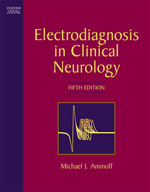|
|
|
| |
 |
|
|

|
-
推薦指數:



|
|
- 內容介紹
|
Electrodiagnosis in Clinical Neurology
by Aminoff, Michael J.
0443066477
Edition 5 , 2005 , CHURCHILL LIVINGSTONE
The New Edition of this respected reference delivers complete, practical guidance on current electrodiagnostic techniques and their clinical applications for investigating problems of both the central and peripheral nervous systems. Completely revised and updated, this 5th Edition provides state-of-the-art knowledge on electroencephalography, electromyography, nerve conduction studies, evoked potentials, polysomnography, and electronystagmography.
Reviews
REVIEW OF THE LAST EDITION: “A standard neurology textbook that has stood the test of time….Currently the best textbook value on the market….The standard toward which all other single volume electrodiagnostic textbooks will need to strive.”—Pediatric Neurology
Features
Emphasizes the clinical applications of each electrodiagnostic technique, providing state-of-the-art guidance for both non-specialists and specialists.
Discusses the principles, scope, limitations, diagnostic importance, prognostic relevance, and complications for each technique.
Clarifies the technical and practical aspects of electrodiagnostic tests with over 700 charts, figures, and tables.
What's New
Includes a new chapter on Magnetoencephalography that discusses the use of this newer modality for the evaluation of patients with disorders such as epilepsy.
Provides a new chapter on Quantitative Electromyography as well as a new chapter on Neurophysiological Evaluation of Sacral Function that includes new discussions of how to evaluate bladder, bowel, and sexual function.
Features revisions and updates to all other existing chapters.
Contents
I. Introduction
1. The Emergence of Electrophysiology as an Aid to Neurology
2. Electrophysiologic Equipment and Electrical Safety
II. Electroencephalography
3. Electroencephalography: General Principles and Clinical Applications
4. Neonatal and Pediatric Electroencephalography
5. Long-Term Monitoring for Epilepsy
6. Ambulatory Electroencephalographic Monitoring
7. Invasive Clinical Neurophysiology in Epilepsy and Movement Disorders
8. Topographic Mapping, Frequency Analysis, and Other Digital Techniques in Electroencephalograpy
9. Intraoperative Electroencephalographic Monitoring
10. Magnetoencephalography
III. Electromyography, Nerve Conduction Studies, and Related Techniques
11. Clinical Electromyography
12. Quantitative Electromyography
13. Nerve Conduction Studies
14. Microneurography as a Clinical research Tool
15. Electrophysiologic Study of Disorders of Neuromuscular Transmission
16. H-Reflex and F-Response Studies
17. The Blink Reflex
18. Electrophysiologic Evaluation of Movement Disorders
19. Evaluation of the Autonomic Nervous System
IV. Evoked Potentials and Related Techniques
20. Electroretinography
21. Visual Evoked Potentials in Clinical Neurology
22. Visual Evoked Potentials in Infants and Children
23. Brainstem Auditory Evoked Potentials: Methodology, Interpretation and Clinical Application
24. Brainstem Auditory Evoked Potentials in Infants
25 Somatosensory Evoked Potentials
26. Somatosensory Evoked Potentials in Infants and Children
27. Motor Evoked Potentials
28. Event-Related Potentials
29. Intraoperative Monitoring by Evoked Potential Techniques
30. Electrophysiologic Evaluation of Sacral Function
V. Testing of Vestibular Function
31. Vestibular Laboratory Testing
VI. Electrophyisiologic Evaluation in Special Situations
32. Polysomnographic Evaluation of Sleep Disorders
33. Electrophysiologic Evaluation of Patients in the Intensive Care Unit
34. Electrophysiologic Evaluation of Brain Death: A Critical Appraisal
35. Use of Neurophysiologic Techniques in Clinical Trials
36. Electrophysiologic Techniques in the Evaluation of Patients with Suspected Neurotoxic Disorders
|
|
|

